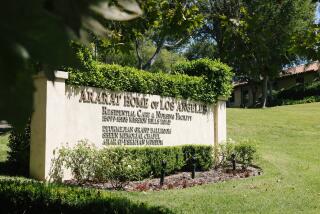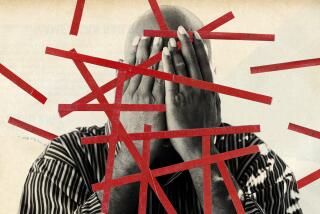For Nation’s Elderly, Hospitals Can Be Dangerous Places
- Share via
My friend’s father, a 77-year-old man I’ll call Mr. Smith, suffered a stroke following elective surgery at a Los Angeles-area hospital. The stroke left him paralyzed on the right side and unable to speak. The family became concerned after noticing a bump on his knee, presumably the result of a fall. They raised the issue of his safety with the hospital. Soon thereafter, Mr. Smith was left alone on a commode in his room. Unable to support his weight, he fell toward his weak side, striking his head on a wall. Only after his wife came to visit and pressed the staff to explain the bump on his head was she told what had happened. The staff physician briefly examined him and told the wife that “falls are common in patients with disabilities.”
A week later at home, Mr. Smith lapsed into a coma. An emergency CAT scan revealed a large subdural hematoma, a blood clot that can develop days after an acute head injury. He ultimately died from the injury.
As a physician devoted to the care of elderly persons and their families, I wasn’t surprised to hear this story. Falls like Mr. Smith’s are regular occurrences when elderly patients are hospitalized. They happen at the best institutions, public and private. The Centers for Disease Control and Prevention in Atlanta reported in November 2000 that 10% of falls occur in health-care institutions. I suspect that only a small fraction of actual falls are reported.
The fact is that hospitals have become unsafe environments for elderly patients. One reason is a critical shortage of skilled hospital workers, particularly geriatric nurses. Although it doesn’t take the technical expertise of a registered nurse to ensure a patient’s physical safety, it is up to the nurse to oversee the safety requirements of patients. If nurses are saddled with too many patients, and too much bureaucratic paperwork, they have no time to train and supervise those under them. The understaffing of hospitals occurs in an environment where, according to the 1999 National Hospital Discharge Survey, patients 65 years old and over accounted for 40% of discharges and used 48% of hospital care days. As the population ages, hospitals have increasing numbers of sicker patients to take care of, and fewer trained staff at their disposal.
Recognizing the problem, a 1999 California law mandates that the state Department of Health Services adopt regulations to establish minimum nurse-to-patient ratios for hospitals by early this year. But while establishing such minimums is an important step, it is meaningless if there aren’t enough nurses to meet the requirements. The current critical shortage of registered nurses is only likely to get worse. Nearly 60% of the RN workforce is over 40 years old, and the percentage of nurses under 30 has fallen nearly 40% since 1980, according to a recent Vanderbilt School of Nursing study. Even if nurses become available, it will take several years for full implementation of the law, and there’s no mandate in it that hospital workers be trained in elderly care.
When a patient falls or experiences an unexpected “adverse event” such as a physical injury in the hospital, staff are required to submit an “incident report.” But patients and their families cannot gain access to these reports. To protect the hospital from having to give up such reports in the event of a lawsuit, they become part of the so-called “peer review process.” Patients are not permitted even to verify whether an incident report is accurate, nor are they routinely informed of any corrective actions taken. The premier review agency for hospitals, the Joint Commission on Accreditation of Healthcare Organizations, has argued for many years that “fear of reprisals, public castigation, and loss of business ... impede the reporting of serious errors.”
But if hospital care for the elderly is to improve, consumers need access to data on “adverse events” in hospitals. Hospitals protested when Medicare required them to make public their outcome statistics, including incidents of surgical complications and mortality. But these data have served the public well, enabling patients to make informed decisions about which hospitals to patronize--if their health plans allow them to choose. Now, data from incident reports should be made similarly available--not by name, of course, in order to protect privacy, but classified according to age, sex, kind of injury and outcome, with statistical comparisons to other hospitals across the community and nationally.
Patients and their families should also have the right to file incident reports. And hospitals should be required to respond to these reports. Although one can be sympathetic to hospitals’ fears of legal exposure, they are institutions that serve the public and should not be immune from honest disclosure or the legal repercussions of failure to act. Hospitals should also be required by Medicare to provide elderly-protection training to all full-time and temporary staff.
The burden shouldn’t be on the family once a patient is in the hospital--but in the absence of better staffing and reporting, it often is. To get high-quality care, families find they have to advocate on behalf of the patient, and, even then, getting appropriate care is not easy. A 2001 article in The Journal of Family Practice reported that even family physicians intervening on behalf of their own parents found the experience frustrating. They wondered how people without physician-advocates in the family could ever hope to manage the fragmentation and poor communication endemic to our current health-care system.
Weekends, evenings and holidays are particularly hazardous, as staffing is even more difficult for the hospital. Increasingly, family and friends of the elderly are staying in the hospital to ensure that the patient is accompanied at all times when out of bed or in the bathroom. Enlightened hospitals allow parents to accompany children to tests and procedures outside the hospital room; they should allow the same for the elderly and their caretakers.
Ultimately, the only way to make health-care environments safer for elderly patients is for greater public accountability and strong private advocacy. If an injury occurs in the hospital, at the very least all hospital and professional expenses incurred as a result of the incident should be borne by the hospital, not by the patient or the insurance carrier. From a policy perspective, federal, state and private entities need to ensure adequate funding for the low-tech, but critically important physical safety of our elderly patients.
*
Joseph W. Spooner is a neurologist and president of The Parent Care Company, a Los Angeles-based elder care consulting company. E-mail: drjoe@parentcarecompany.com
More to Read
Sign up for Essential California
The most important California stories and recommendations in your inbox every morning.
You may occasionally receive promotional content from the Los Angeles Times.













